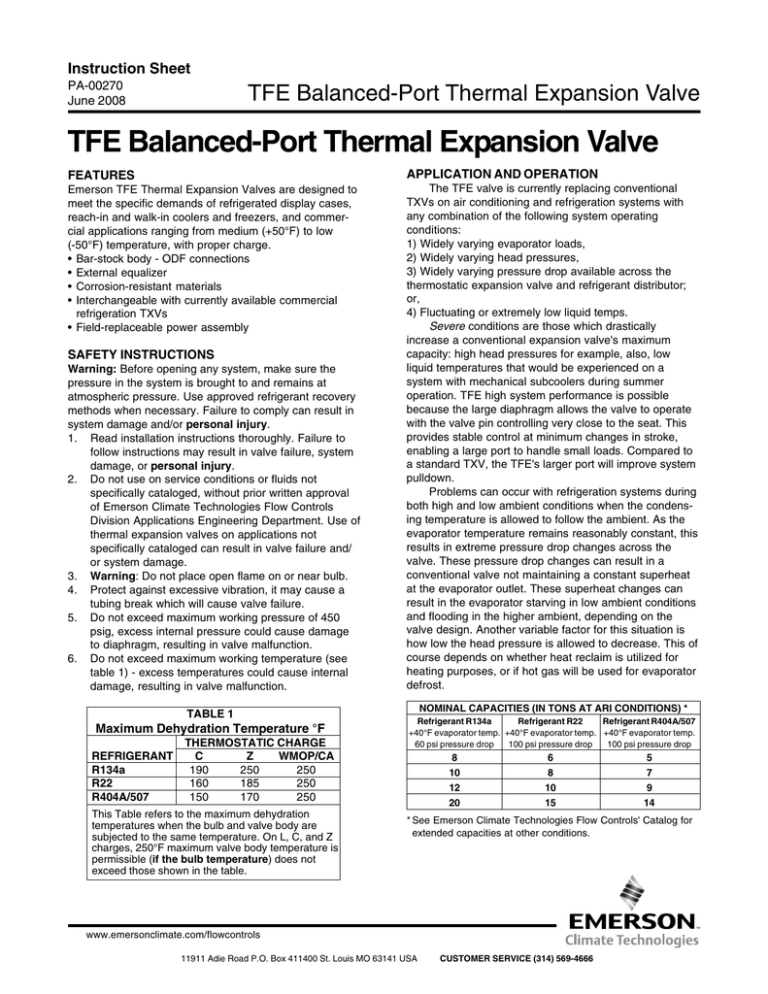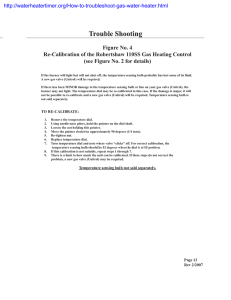TFE Balanced-Port Thermal Expansion Valve
advertisement

Instruction Sheet PA-00270 June 2008 TFE Balanced-Port Thermal Expansion Valve TFE Balanced-Port Thermal Expansion Valve FEATURES APPLICATION AND OPERATION Emerson TFE Thermal Expansion Valves are designed to meet the specific demands of refrigerated display cases, reach-in and walk-in coolers and freezers, and commercial applications ranging from medium (+50°F) to low (-50°F) temperature, with proper charge. • Bar-stock body - ODF connections • External equalizer • Corrosion-resistant materials • Interchangeable with currently available commercial refrigeration TXVs • Field-replaceable power assembly The TFE valve is currently replacing conventional TXVs on air conditioning and refrigeration systems with any combination of the following system operating conditions: 1) Widely varying evaporator loads, 2) Widely varying head pressures, 3) Widely varying pressure drop available across the thermostatic expansion valve and refrigerant distributor; or, 4) Fluctuating or extremely low liquid temps. Severe conditions are those which drastically increase a conventional expansion valve's maximum capacity: high head pressures for example, also, low liquid temperatures that would be experienced on a system with mechanical subcoolers during summer operation. TFE high system performance is possible because the large diaphragm allows the valve to operate with the valve pin controlling very close to the seat. This provides stable control at minimum changes in stroke, enabling a large port to handle small loads. Compared to a standard TXV, the TFE's larger port will improve system pulldown. Problems can occur with refrigeration systems during both high and low ambient conditions when the condensing temperature is allowed to follow the ambient. As the evaporator temperature remains reasonably constant, this results in extreme pressure drop changes across the valve. These pressure drop changes can result in a conventional valve not maintaining a constant superheat at the evaporator outlet. These superheat changes can result in the evaporator starving in low ambient conditions and flooding in the higher ambient, depending on the valve design. Another variable factor for this situation is how low the head pressure is allowed to decrease. This of course depends on whether heat reclaim is utilized for heating purposes, or if hot gas will be used for evaporator defrost. SAFETY INSTRUCTIONS Warning: Before opening any system, make sure the pressure in the system is brought to and remains at atmospheric pressure. Use approved refrigerant recovery methods when necessary. Failure to comply can result in system damage and/or personal injury. 1. Read installation instructions thoroughly. Failure to follow instructions may result in valve failure, system damage, or personal injury. 2. Do not use on service conditions or fluids not specifically cataloged, without prior written approval of Emerson Climate Technologies Flow Controls Division Applications Engineering Department. Use of thermal expansion valves on applications not specifically cataloged can result in valve failure and/ or system damage. 3. Warning: Do not place open flame on or near bulb. 4. Protect against excessive vibration, it may cause a tubing break which will cause valve failure. 5. Do not exceed maximum working pressure of 450 psig, excess internal pressure could cause damage to diaphragm, resulting in valve malfunction. 6. Do not exceed maximum working temperature (see table 1) - excess temperatures could cause internal damage, resulting in valve malfunction. TABLE 1 Maximum Dehydration Temperature °F REFRIGERANT R134a R22 R404A/507 THERMOSTATIC CHARGE C Z WMOP/CA 190 250 250 160 185 250 150 170 250 This Table refers to the maximum dehydration temperatures when the bulb and valve body are subjected to the same temperature. On L, C, and Z charges, 250°F maximum valve body temperature is permissible (if the bulb temperature) does not exceed those shown in the table. NOMINAL CAPACITIES (IN TONS AT ARI CONDITIONS) * Refrigerant R134a Refrigerant R22 Refrigerant R404A/507 +40°F evaporator temp. +40°F evaporator temp. +40°F evaporator temp. 60 psi pressure drop 100 psi pressure drop 100 psi pressure drop 8 10 12 20 6 8 10 15 5 7 9 14 * See Emerson Climate Technologies Flow Controls' Catalog for extended capacities at other conditions. www.emersonclimate.com/flowcontrols 11911 Adie Road P.O. Box 411400 St. Louis MO 63141 USA CUSTOMER SERVICE (314) 569-4666 TFE NOMENCLATURE TF E 10 H C Valve Series External Equalizer Capacity Nominal Rating in Tons Refrigerant Code M = R134a H = R22 S = R404A P = R507 Charge Code C = med temp Z = low temp W = MOP (if needed) Figure 1 Always direct torch flame away from valve body when brazing. Figure 2 EXTERNAL EQUALIZER EXTERNAL EQUALIZER EVAPORATOR EVAPORATOR REMOTE BULB EXPANSION VALVE DISTRIBUTOR INCORRECT REMOTE BULB LOCATION SHOWN TRAPPED REMOTE BULB EXPANSION VALVE DISTRIBUTOR CORRECT REMOTE BULB LOCATION SHOWN FREE-DRAINING INSTALLATION INSTRUCTIONS 1. Warning: Before opening any system, make sure the pressure in the system is brought to and remains at atmospheric pressure. Use approved refrigerant recovery methods when necessary. Failure to comply can result in system damage and/or personal injury. 2. Valves may be installed in any position, but should be located as close as possible to the distributor or evaporator inlet. 3. Foreign matter in the thermal expansion valve may cause diaphragm failure, flooding, or starving of the valve. Use of an Emerson liquid line filter-drier is strongly recommended. 4. Valves are factory set to a specific superheat. If adjustment is needed, refer to Superheat Adjustment section for proper procedure. Improper adjustment of superheat can result in system damage. 5. Proper valve sizing is important. An oversized valve may result in erratic control. An undersized valve considerably reduces system capacity. 6. Be sure valve is installed with its flow arrow corresponding to the flow direction thru the piping. 7. Install line connections to valve. On valves with solder connections, wrap wet cloths around the valve to prevent valve damage while brazing. Direct torch away from valve (see Figure 1). 8. Attach the remote bulb to the suction line as close to the evaporator outlet as possible. Position the bulb at the 4 or 8 o’clock position. Clean surface of suction line where the remote bulb is to be attached, and then securely fasten the bulb with straps provided. If the remote bulb can be affected by the surrounding ambient, then the bulb should be insulated with a material that will not absorb water. See figure 2. 9. Connect one end of the external equalizer line to the valve. Connect the other end to the suction line slightly downstream from the remote bulb location and positioned so that it cannot siphon oil from the suction line. 10. Check for leaks, sufficient system refrigerant charge, and be sure no flash gas is present before attempting to check valve operation. 11. The expansion valve must be free of all contaminants - install an Emerson liquid line filter-drier before the valve. MEASURING SUPERHEAT 2. 3. 4. Determine the suction pressure with an accurate gauge at the evaporator outlet (see P in figure 3). On selfcontained systems, the suction pressure may be read at the compressor suction connections. From refrigerant pressure-temperature tables, determine saturation temperature at observed suction pressure (TEMPP). Measure temperature of suction gas at thermal expansion valve remote bulb location (TEMPT). Subtract saturation temperature (read from tables in step 2) from temperature measured in step 3; the difference is the superheat of the suction gas. SUPERHEAT ADJUSTMENT Emerson thermal expansion valves are factory set to a specific superheat - however, the superheat should be adjusted for the application. To adjust the valve to other superheat settings: 1. Remove the seal cap from bottom of valve. 2. Turn the adjustment screw clockwise to increase superheat and counterclockwise to decrease superheat. One complete 360° turn changes the superheat approximately 3-4°F, regardless of the refrigerant type. As much as 30 minutes may be required for the system to stabilize after the adjustment is made. 3. Replace and hand-tighten seal cap. Caution: When adjusting superheat setting - when stop is reached, any further turning adjustment will damage valve. TEMPT 40° – – TEMPP = SUPERHEAT 33° = 7° 69 PSIG = 40°F 59 PSIG = 33°F EXTERNAL EQUALIZER 1. T P 40°F 59 PSIG 59 PSIG = 40°F FIGURE 3 POWER ASSEMBLY REPLACEMENT Warning: Before removing any power assembly, the system must be brought to, and remain at, atmospheric pressure. Failure to comply can result in system damage and/or personal injury. 1. To remove the power assembly, first ensure the valve is free of any moisture or ice. Do not heat valve with torch. Use "heat gun" or apply hot rags to valve to melt ice. 2. Remove the remote bulb from suction line. 3. Turn power assembly counterclockwise with proper size wrench, being careful not to damage body. 4. With power assembly removed, care must be taken to prevent any foreign material from entering the valve. 5. Care must also be taken not to damage the threads or surface area. 6. Install new power assembly with no oil or thread compound, and torque to 375-425 in. lbs. TFE CUTAWAY VIEW REMOTE BULB POWER ELEMENT RETAINING RING SEAL SPRING GUIDE WASHER PIN SPRING ADJUSTING STEM ADJUSTING STEM ADAPTER ADJUSTING NUT O-RING RETAINING RING O-RING SEAL CAP TFE DIMENSIONAL DIAGRAMS AND TABLES Inlet/Outlet Fittings (in.) Connections Inlet 1/4 ODF 3/8 ODF 1/2 ODF 5/8 ODF 7/8 ODF Inlet Outlet C MIN. Equaliz er (E) Outlet A B D MIN. 1/4 ODF 3/8 ODF 0.25 0.38 0.31 0.37 1/2 ODF 0.25 0.50 5/8 ODF 0.25 0.63 3/8 ODF 0.38 0.38 1/2 ODF 0.38 0.50 0.37 5/8 ODF 0.38 0.63 0.50 7/8 ODF 0.38 0.88 1/2 ODF 0.50 0.50 0.37 0.37 5/8 ODF 0.50 0.63 0.37 0.50 7/8 ODF 0.50 0.88 0.37 0.76 SAE 0.50 0.31 0.31 0.76 5/8 ODF 0.63 0.63 0.50 0.50 7/8 ODF 0.63 0.88 0.50 0.76 1-1/8 ODF 0.63 1.13 0.50 0.91 7/8 ODF 0.88 0.88 0.76 0.76 1-1/8 ODF 0.88 1.13 0.76 0.91 1.70 1.65 Remote Bulb Charge C , A, Z C A, AA Tubing Length (Ft) F 2, 2-1/2, 5 3.06 10 3.56 15, 20, 30 4.81 40, 50 6.19 2-1/2, 5, 10 2.31 G 0.63 0.76
